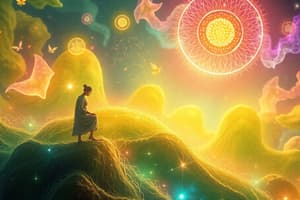Podcast
Questions and Answers
What is the primary distinction between growth and development in living organisms?
What is the primary distinction between growth and development in living organisms?
- Growth represents a quantitative change, whereas development signifies a qualitative change. (correct)
- Growth occurs in multicellular organisms only, while development is exclusive to unicellular organisms.
- Both growth and development are the same process that simply increases cell count.
- Growth is about becoming more complex, while development is simply getting bigger.
Which statement accurately describes unicellular organisms?
Which statement accurately describes unicellular organisms?
- They possess multiple specialized cells that perform various functions.
- They are the simplest level of life and can never develop.
- They can grow, but do not undergo any form of development.
- They consist of only one cell and can respond to environmental changes. (correct)
How do autotrophs differ from heterotrophs?
How do autotrophs differ from heterotrophs?
- Autotrophs create their own food through natural processes, whereas heterotrophs obtain energy by consuming organic material. (correct)
- The primary function of autotrophs is reproduction, unlike heterotrophs.
- Autotrophs must consume other organisms for energy, while heterotrophs create their own food.
- All autotrophs rely on photosynthesis, while heterotrophs do not.
What role does homeostasis play in living organisms?
What role does homeostasis play in living organisms?
Which of the following correctly characterizes asexual reproduction?
Which of the following correctly characterizes asexual reproduction?
What is the significance of DNA in living organisms?
What is the significance of DNA in living organisms?
What does the term 'survival of the fittest' refer to in the context of evolution?
What does the term 'survival of the fittest' refer to in the context of evolution?
Which levels of organization are correctly identified as living levels in biological systems?
Which levels of organization are correctly identified as living levels in biological systems?
Flashcards
Growth and Development
Growth and Development
The process by which an organism increases in size and complexity.
Cells
Cells
All living things are composed of these basic units of life.
Homeostasis
Homeostasis
The ability to maintain a stable internal environment despite external changes.
Reproduction
Reproduction
Signup and view all the flashcards
Autotrophs
Autotrophs
Signup and view all the flashcards
Heterotrophs
Heterotrophs
Signup and view all the flashcards
Evolution
Evolution
Signup and view all the flashcards
Cell Differentiation
Cell Differentiation
Signup and view all the flashcards
Study Notes
Characteristics of Life
-
Growth and Development:
- All life begins as a single cell.
- Growth is the increase in the amount of living material (cells).
- Development is the differentiation of cells and tissues.
- Growth and development occur in unicellular and multicellular organisms, though to different extents and in different ways. Growth is quantitive change, development is qualitative.
- Unicellular organisms exhibit both growth and development.
- Multicellular organisms undergo continuous growth and development.
-
Made of Cells:
- All living things are composed of cells.
- Cells can be unicellular (single-celled) or multicellular (many-celled).
- Cells are of two basic types: prokaryotic and eukaryotic.
- All cells contain DNA (deoxyribonucleic acid).
-
Levels of Organization:
- Unicellular organisms represent the simplest level of life.
- Multicellular organisms have multiple levels of cellular organization, from cells to tissues, organs, to organ systems. Non-living levels - atoms, molecule, and cell organelles.
- Cells specialize and work together.
- There's a hierarchy of organization: cell, tissue, organ, organ system, organism, population, community, ecosystem, biome.
-
Respond to Stimuli:
- Organisms respond to internal and external changes in their environment.
- Homeostasis is maintaining the internal environment in the face of external changes.
- Organisms can respond to a wide range of stimuli, such as temperature changes, light, sound, and touch, both internally and externally. Examples include sweating, shivering, digestive actions, and panting.
-
Require Energy:
- All living things need a source of energy to power life processes.
- Autotrophs (producers) create their own food, often through photosynthesis. (phototrophs).
- Heterotrophs (consumers) obtain energy by consuming other organisms (herbivores, carnivores, omnivores, detritivores, decomposers).
- Cellular respiration is a key process for energy release in heterotrophs. Chemotrophs obtain energy from chemical reactions.
-
Reproduction and Evolution:
- Reproduction is not essential for the survival of an individual organism but for the survival of a species.
- Asexual reproduction involves a single organism creating offspring without the need of another.
- Sexual reproduction requires two parents.
- Evolution is the process by which organisms adapt to their environment over time. Evolution affects the genes and DNA of future generations—changes in genetics cause adaptability.
- Organisms adapt to their environment.
- Extinction is the disappearance of a species from Earth.
Studying That Suits You
Use AI to generate personalized quizzes and flashcards to suit your learning preferences.




